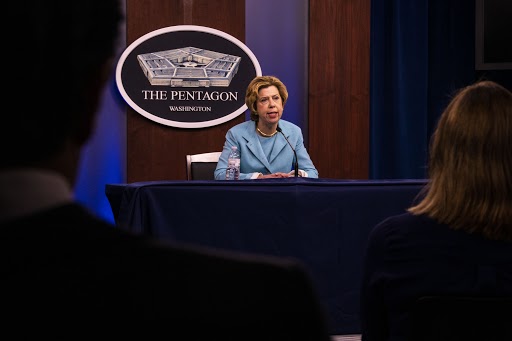The Pentagon’s top acquisition official anticipates the military will see a three-month setback across its major defense acquisition programs as the coronavirus pandemic throws contractors and program officials off their usual rhythm.
“Aviation is actually the most highly impacted sector we have right now, so the 20 different memos [Kim Herrington, the acting principal director of defense pricing and contracting,] put out are really to make sure cash flows and we quickly get on contract so we can keep going,” Defense Department acquisition chief Ellen Lord said April 20.
That includes some of the Air Force’s highest-profile initiatives, such as the F-35 Joint Strike Fighter, the B-21 Raider, the KC-46 Pegasus tanker, new Air Force One planes, T-7A Red Hawk trainer jet, and the HH-60W Jolly Green II helicopter. USAF also shares some major aircraft programs like the V-22, C-130J, MQ-9, and RQ-4 with other services. Small space launch is another main area of concern.
“We continue to carefully and methodically track the state of the defense industrial base through [the Defense Contract Management Agency] for prime companies, and [the Defense Logistics Agency] for vendors. Out of 10,509 major prime companies, 106 are closed, with 68 companies having closed and reopened. Out of 11,413 vendor base companies, 427 are closed with 147 having closed and reopened,” Lord said.
International closures also are impacting the industrial base, she noted. “Particularly of note is Mexico, where we have a group of companies that are impacting many major primes. … I spoke with our U.S. ambassador to Mexico and today I am sending the Mexican foreign minister to ask for help [to] reopen international suppliers there. These companies are especially important for our U.S. airframe production.”
Lord said the three-month slowdown would cost the Pentagon “billions and billions” of dollars, but declined to say how much the department wants to be reimbursed in future legislation.
To help ward off contracting inefficiencies caused by the pandemic, Lord said DOD is seeking additional help for the industrial base in the next congressional stimulus package. The department also wants support from the Defense Production Act to help factories switch to and ramp up production of different goods like face masks. The Pentagon’s request is heading to the Office of Management and Budget for review before it is incorporated into the formal ask from the executive branch to the legislative branch.
Officials particularly want the DPA’s help for areas like aircraft, radars, munitions and missiles, space, shipbuilding, soldier systems, and ground systems. DOD has already received $1 billion as part of the DPA and is splitting it into $750 million for medical resources and $250 million for the defense industrial base. In addition to converting facilities for emergency use, DPA allows the Pentagon to buy long-lead materials for its own programs and keep suppliers from turning to foreign investors.
“We anticipate receiving blanket DPA Title III approval for health care and medical resources, and we are working with our interagency partners to plan and obligate,” Lord said. The department’s first DPA Title III project provided $133 million to 3M, O&M Halyard, and Honeywell to produce more than 39 million N95 masks in the next three months.
DOD so far has issued 5,500 contracting actions worth more than $1.5 billion in response to the COVID-19 pandemic. The bulk of that funding has gone toward building mobile military medical hospitals.
Amid the vast sums of money that lawmakers have so far authorized as part of the U.S. pandemic response, including $10.5 billion for DOD, the Treasury Department has a $17 billion pot available for loans to “businesses critical to maintaining national security.”
Undersecretaries at the Pentagon and Treasury are working together on guidance for how to dole out the $17 billion, Lord said.
“We actually have ranked different sectors as well,” she added. “We set the criteria up, we’re just now beginning to work with them on the choices. That has been a very, very good interagency process.”
At the top of that priority list are the Pentagon’s nuclear modernization projects and the Missile Defense Agency’s work. Contractors should work with the government agency best suited to their financial needs, Lord said. For example, small companies should be routed to the Small Business Administration.
“We’re looking where the greatest pain points are, and again, it’s really aviation, shipbuilding, and small space launch,” Lord said.
She noted that oversight of the funding infusions will occur through the department’s typical auditing processes. DOD is relying on its contractors and industry associations to publicize and track how downstream suppliers are receiving that cash.
“For the last three weeks, we have accelerated payments to our supply chain, and I am pleased to announce another $50 million this week, bringing our total to $156 million,” Lockheed Martin Chief Executive Officer Marillyn Hewson said April 9.
Lord noted that the defense industry this week will start receiving $3 billion in increased cash flow as progress payments ramp up. The government hopes that accelerating these payments will help keep its supply chain intact.


